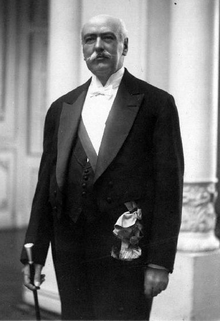Juan Luis Sanfuentes
Juan Luis Sanfuentes Andonaegui (born December 27, 1858 in Santiago de Chile , † July 16, 1930 in Camarico) was President of Chile from 1915 to 1920 .
Life
Sanfuentes was raised by his brother Enrique after the untimely death of his parents. To 1879 he studied at the Universidad de Chile Law . He then married Ana Echazarreta, with whom he had five children.
After the fall of President José Manuel Balmaceda , for whom Sanfuentes had worked, he temporarily withdrew from political life and worked as a businessman. However, he remained connected to the Liberal Democratic Party, loyal to Balmaceda, which split under his leadership in 1900, but unified again in 1901 and supported the candidacy of Germán Riesco Errázuriz .
His predecessor, the outgoing President Federico Errázuriz Echaurren , briefly made Sanfuentes Minister of Finance, followed in the same year by the appointment of the new President Riesco as Minister of Justice and Education, and later that year as Minister of Finance.
Sanfuentes also sat for the regions of Valdivia (1900 to 1906) and Concepción (1906 to 1918) in the Chilean Senate.
Under the presidency of Pedro Montt Montt , the Liberal Democratic Party split once more; again Sanfuentes took over the leadership of one of the two factions.
In 1915 the party alliance La Coalición was formed from conservatives, liberal democrats and nationalists; Juan Sanfuentes was named her presidential candidate. His opponent from the Alianza Liberal was Javier Ángel Figueroa Larraín. After an election campaign marked by violence and allegations of fraud, none of the candidates achieved an absolute majority, so that the presidential election, according to the Chilean constitution, was up to Congress. He elected Sanfuentes as the new President of Chile.
During his presidency, Sanfuentes repeatedly caused conflicts with parliament and did not shy away from harsh attacks on his political opponents.
During the First World War , for example, he decided to maintain Chile's neutrality. This allowed the country to continue trading with all belligerent powers, and in view of the global demand for saltpetre , export revenues rose. Nevertheless, his position in parliament and among the many Chileans who had immigrated from France and England was controversial, especially since Chile's neighboring countries Peru and Bolivia , with which Chile had long-term territorial conflicts, sided with the Allies.
When the war was over in 1918, Chile joined the League of Nations .
Domestically, the massive expansion of public schools and state support, which should also allow poor children to attend primary schools, were the most important achievements of Sanfuentes. At the end of his term in office, in 1920, compulsory schooling was introduced in Chile, despite massive resistance from the conservatives.
In 1916 workers' compensation insurance was set up, and the first pension insurance systems were set up for some occupational groups (such as railway workers). Nonetheless, workers' resistance to the government and the social system, which built on the enormous inequality between a small upper class and the vast majority of the dispossessed, grew in the cities and metropolitan areas. In the wake of the October Revolution in Russia , unions and political organizations were formed in Chile to advocate workers' rights.
Social unrest intensified when the war in Europe was over and Chile was no longer in demand as a supplier of raw materials. The economy of Chile suffered badly from the collapse of the saltpetre business after the end of the war.
Another source of conflict was the relationship between state and church. In January 1919, the new Archbishop Crescente Errázuriz Valdivieso broke the long neutrality of the Catholic Church and campaigned for the Conservative Party, which he believed was most likely to represent the ideals of the Church.
In 1919 the Congress gave Sanfuentes far-reaching powers to put down the workers' uprisings in the saltpetre towns of the Antofagasta and Tarapacá regions . Labor leaders were banished to the less developed and sparsely populated south of the country.
A general strike by coal workers in 1920 marked the beginning of further uprisings by large sections of the workers. The presidential elections of 1920 could nevertheless be held; the candidate of the Alianza Liberal , Arturo Alessandri Palma won and took over the office constitutionally from Juan Sanfuentes in December.
Sanfuentes was only 62 years old at the time. He turned his back on politics and lived with his wife in seclusion for the next ten years on his estate near Camarico, where he died in 1930, three years after his wife.
literature
- Manuel Rivas Vicuña: Historia politica y parliamentaria de Chile, 1891–1920 . Part 3: La administración de Juan Luis Sanfuentes . Biblioteca Nacional, Santiago de Chile 1964, pp. 528-925.
Web links
| personal data | |
|---|---|
| SURNAME | Sanfuentes, Juan Luis |
| ALTERNATIVE NAMES | Sanfuentes Andonaegui, Juan Luis |
| BRIEF DESCRIPTION | President of Chile |
| DATE OF BIRTH | December 27, 1858 |
| PLACE OF BIRTH | Santiago de Chile |
| DATE OF DEATH | July 16, 1930 |
| Place of death | Camarico |

